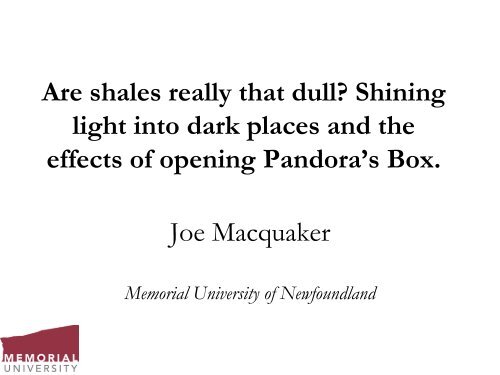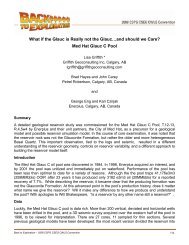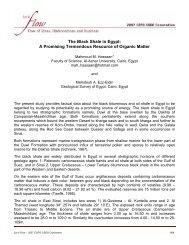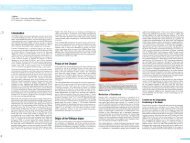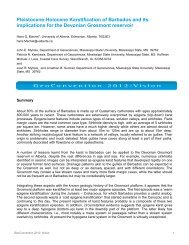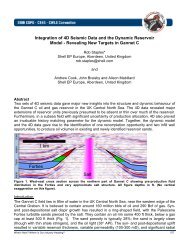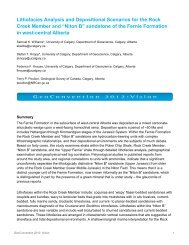Sedimentology of mud - Canadian Society of Petroleum Geologists
Sedimentology of mud - Canadian Society of Petroleum Geologists
Sedimentology of mud - Canadian Society of Petroleum Geologists
You also want an ePaper? Increase the reach of your titles
YUMPU automatically turns print PDFs into web optimized ePapers that Google loves.
Are shales really that dull? Shining<br />
light into dark places and the<br />
effects <strong>of</strong> opening Pandora’s Box.<br />
Joe Macquaker<br />
Memorial University <strong>of</strong> Newfoundland
Aims<br />
a) Discuss our perceptions about the origins <strong>of</strong> “black shales”<br />
b) Provide you with microtextural and compositional data<br />
(optical and electron optical techniques) from thin sections <strong>of</strong><br />
some “classic black shales”. Supplement these data by<br />
geochemical analyses. I will be “Shining light into dark<br />
places!”<br />
c) Review from where the sediment components in siliciclastic<br />
<strong>mud</strong>stones are derived.<br />
d) Review mechanisms likely responsible for sediment transport<br />
and dispersal in these organic carbon-rich successions.<br />
e) Discuss what happens to organic-carbon rich <strong>mud</strong>stones<br />
shortly after they have been deposited.<br />
f) Discuss the implications <strong>of</strong> these data for our existing “black<br />
shale” depositional models - i.e. the effects <strong>of</strong> opening<br />
Pandora’s Box.
Before I start I would like to thank.<br />
• AAPG and Memorial University for funding this trip<br />
and allowing me to be away from my teaching duties<br />
• My co-conspirators: including Kevin Taylor (MMU),<br />
Kevin Bohacs (ExxonMobil), Sam Bentley (LSU),<br />
Margaret Keller (USGS), Guy Plint (UWO), Per-Kent<br />
Pedersen (U <strong>of</strong> C), Quinn Passey (ExxonMobil), Bruce<br />
Hart (ConocoPhillips), Juergen Schieber (Indiana) and<br />
Andy Aplin (Newcastle)<br />
• My recent students: Megan Laracy, Samer Ghadeer,<br />
Said Al-Balushi, Matt Johnson.<br />
• This research has been funded variously by NSERC,<br />
ExxonMobil, ConocoPhillips, Nalcor, and Statoil.
Real world observations - the problem!<br />
i) Toarcian aged Mulgrave Shale Member including the Jet<br />
Rock (32 m thick) exposed on the Yorkshire Coast (UK),<br />
and deposited over approximately 1 million years.<br />
ii) Very large volumes <strong>of</strong> <strong>mud</strong> deposited in these settings.<br />
iii) Base <strong>of</strong> this succession contains the Toarcian OAE.
Real World Observations: sub-log scales<br />
(i) Fine-grained!<br />
(ii) No obvious evidence <strong>of</strong> any<br />
physical sedimentary<br />
structures e.g. ripples,<br />
erosion surfaces, rip-up<br />
clasts.<br />
(iii) “Varved deposit”<br />
composed <strong>of</strong> thin<br />
intercalations <strong>of</strong> clay<br />
mineral and organic<br />
carbon-rich material and<br />
silt-rich material.<br />
(iv) Fine grained populations <strong>of</strong><br />
pyrite framboids.<br />
(v) Many anoxic proxies (trace<br />
elements, stable isotopes<br />
and biomarkers).<br />
Jet Rock, deposited during<br />
Toarcian OAE, up to 14% TOC
Real world observations - the problem!<br />
i) Kimmeridge Clay Formation (Upper Jurassic, 500 m thick in<br />
Wessex Basin deposited over 8 million years).<br />
ii) Main source rock in North Sea (much <strong>of</strong> it apparently anoxic).<br />
iii) Very large volumes <strong>of</strong> <strong>mud</strong> deposited in these settings. Mud<br />
was deposited both at high and low sea-level stand.
Real World Observations: sub-log scales<br />
Fine-grained succession! That exhibits high gamma, low densities and high<br />
neutron porosities, no obvious sedimentary structures other than preserved<br />
lamination, although rare shell pavements, concretionary horizons,<br />
populations <strong>of</strong> small pyrite framboids, anoxic photic zone biomarkers are<br />
all present<br />
Kimmeridge Clay Formation up to 52% TOC
Perceptions and models<br />
These attributes mean that geologists using proxy data commonly interpret:<br />
• Organic carbon-rich <strong>mud</strong>stones deposited on continental shelves away<br />
from obvious slopes, as having been deposited by suspension settling, in<br />
low energy environments as a continuous rain <strong>of</strong> detritus, in settings<br />
where the bottom waters were either persistently anoxic or dysoxic.<br />
• Deposition occurring from buoyant plumes derived from either rivers or<br />
zones <strong>of</strong> high primary production in the photic zone. Very little<br />
evidence <strong>of</strong> advective transport at the sediment water interface.<br />
• During deposition fine-grained clastic sediment in these environments<br />
bypassed the proximal portions <strong>of</strong> the continental shelf resulting in there<br />
being little lateral lith<strong>of</strong>acies variability and lith<strong>of</strong>acies exhibiting<br />
widespread draping geometries.<br />
• Climate driven processes linked to clastic dilution versus primary<br />
production and variable bottom water anoxia were responsible for<br />
temporal facies variability.<br />
• Variability in these successions using Milankovitch forcing mechanisms.
Current paradigm for sediment transport<br />
continental shelves is:<br />
• Marginal marine sands dispersed basinward by either storms (ripcurrents,<br />
relaxation-curents), tides or gravity-driven density flows<br />
(turbidites).<br />
• No mechanism to transfer large volumes <strong>of</strong> fine-grained sediment<br />
<strong>of</strong>fshore, particularly at high sea-level stands, because sediment<br />
transport is dominated by geostrophic flows forming a near shore<br />
<strong>mud</strong>-belt. Insufficient slope on continental shelves (
Shining light into dark places
Kimmeridge Clay Formation<br />
All KCF samples collected from this succession
Kimmeridge Clay Formation - intraclasts<br />
Blackstone up to 52% TOC
Kimmeridge Clay Formation<br />
>TOC in intraclasts host sediment quartz rich<br />
Blackstone up to 52.3% TOC<br />
Top <strong>of</strong> Blackstone 36.1% TOC
Kimmeridge Clay Formation<br />
In-situ. Agglutinated, benthic foraminifer<br />
Blackstone up to 52.3% TOC<br />
Top <strong>of</strong> Blackstone 36.1% TOC<br />
Middle <strong>of</strong> Blackstone 44% TOC
Kimmeridge Clay Formation<br />
Normally graded, starved ripple laminae. Note curved<br />
lower contacts.<br />
0.45 m above Blackstone, 4.5% TOC<br />
Macquaker and Bohacs, 2007
Kimmeridge Clay Formation<br />
Burrow mottled silt-bearing, clay-rich siliciclastic mst<br />
0.45 m above Blackstone, 4.5% TOC<br />
1.05 m above Blackstone, 4.6% TOC
Kimmeridge Clay Formation<br />
Stacked succession <strong>of</strong> thin bedded, sharp based<br />
carbonaceous <strong>mud</strong>stones with downlapping laminae.<br />
0.45 m above Blackstone, 4.5% TOC<br />
0.45 m above Blackstone, 13% TOC<br />
1.05 m above Blackstone, 4.6% TOC
Kimmeridge Clay Formation<br />
Discontinuous wavy laminae composed <strong>of</strong> algal<br />
bodies, organic carbon and calcareous pellets.<br />
Kimmeridge Clay Formation<br />
Horizontal thin section <strong>of</strong> discrete organo-minerallic<br />
aggregates in silt-rich matrix<br />
Kimmeridge Clay Formation<br />
BSEI <strong>of</strong> coccolith rich fecal pellet and enclosing<br />
organic matter.<br />
Shining more light into dark<br />
places
Mulgrave Shale<br />
Member (Jet<br />
Rock), Lower<br />
Jurassic,<br />
Toarcian<br />
Most <strong>of</strong> the following<br />
Mulgrave Shale samples<br />
collected from this<br />
succession
Mulgrave Shale Member<br />
Sharp based, beds with wavy laminae and erosional<br />
truncation <strong>of</strong> laminae. Base <strong>of</strong> Millstone.<br />
Erosion<br />
Erosion<br />
Erosion
Mulgrave Shale Member<br />
Sharp based, beds with wavy laminae and erosional<br />
truncation <strong>of</strong> lamina. Note shell pavements<br />
Erosion<br />
Erosion<br />
Erosion<br />
MC0207 6.7% TOC
Mulgrave Shale Member<br />
Normally graded beds with discontinuous wavy laminae that<br />
exhibit downlapping geometries.<br />
MC0201, 14% TOC<br />
Termination Termination<br />
Termination
Mulgrave Shale Member<br />
Normally graded beds with sharp bases, pellets and organominerallic<br />
aggregates.<br />
MC0201, 14% TOC<br />
MC0203, 5.5% TOC<br />
Termination Downlap
Mulgrave Shale Member<br />
BSEI image, detail <strong>of</strong> coccolith-rich pellets and organominerallic<br />
aggregates.<br />
MC0201, 14% TOC<br />
MC0203, 5.5% TOC<br />
Downlap Downlap MC0203, 5.5% TOC
Mulgrave Shale Member<br />
Thin bedded organic carbon bearing clay rich <strong>mud</strong>stone. Individual beds<br />
are sharp based, have discontinuous silt lags at their bases, overlain by<br />
discontinuous pelleted laminae and capped by homogenized laminae<br />
Ravenscar 6, 3.5% TOC<br />
Homogenized laminae<br />
Pelleted laminae<br />
Silt lag
Mulgrave Shale Member<br />
Sub-horizontal thin section through partially homogenized organiccarbon<br />
bearing clay-rich <strong>mud</strong>stone with organo-minerallic aggregates.<br />
Ravenscar 6, 3.5% TOC<br />
PM127 middle<br />
Homogenized laminae Silt lag<br />
Pelleted laminae<br />
Ghadeer and Macquaker, 2011
Mulgrave Shale Member<br />
Detail <strong>of</strong> sub-horizontal thin section scan with organo-minerallic<br />
aggregate in clay-rich matix. Note some framboidal pyrite.<br />
Ravenscar 6, 3.5% TOC<br />
PM127 middle<br />
Homogenized laminae Silt lag<br />
Pelleted laminae<br />
Ghadeer and Macquaker,<br />
2011<br />
PM127 middle
Grey Shale Member<br />
Normally graded beds with sharp bases, discontinuous homogenous laminae that<br />
downlap onto the underlying bedding planes, overlain by wavy continuous intercalated<br />
silt and clay rich laminae and clay-rich drapes (triplets).<br />
Grey Shale 10-14
Cleveland Ironstone Formation<br />
Normally graded beds with sharp bases, discontinuous homogenous laminae that<br />
downlap onto the underlying bedding planes, overlain by wavy continuous intercalated<br />
silt and clay rich laminae and burrow mottled clay-rich drapes (triplets).<br />
Grey Shale 10-14<br />
Cleveland Ironstone Formation
Mulgrave Shale Member<br />
Normally graded beds with sharp bases, discontinuous silt- and clay-rich laminae close to<br />
their bases (some subtle downlap) organo-minerallic rich laminae in their middle portions<br />
and more homogenized laminae towards their tops (triplets). Note shell pavement.<br />
Grey Shale 10-14<br />
Cleveland Ironstone Formation<br />
Mulgrave Shale Member
Shining even more light into<br />
dark places!
Second White Speckled Shale Member, Alberta<br />
(Cenomanian - Turonian)<br />
Howard Creek
Second White Speckled Shale Member, Alberta<br />
(Cenomanian - Turonian)<br />
Stacked succession <strong>of</strong> normally graded thin beds that contain<br />
downlapping non-parallel laminae<br />
WS2 30 borehole<br />
Downlapping laminae terminations
Second White Speckled Shale Member, Alberta (Cenomanian -<br />
Turonian)<br />
Clay-bearing, silt-rich lithic siliciclastic <strong>mud</strong>stone. The laminae contain<br />
abundant silt-sized partially compacted aggregates composed <strong>of</strong> clay<br />
minerals and organic carbon and lithic grains.<br />
WS2 borehole
Second White Speckled Shale Member, Alberta<br />
(Cenomanian - Turonian)<br />
Stacked succession <strong>of</strong> thin bedded <strong>mud</strong>stones. The sample contains parallel<br />
laminae and an homogenous interval. Note abundant fine sand-sized lithic<br />
grains<br />
WS2 borehole
Greenhorn Formation, Cenomanian - Turonian (Kansas)<br />
Stacked succession <strong>of</strong> thin bedded, normally graded calcareous <strong>mud</strong>stones. The<br />
sample contains both ripple laminated and homogenized beds.<br />
RKB#1 1040.4<br />
RKB#1 1040.4
Greenhorn Formation, Cenomanian - Turonian (Kansas)<br />
Silt-bearing clay-rich calcareous <strong>mud</strong>stones. Foraminifer,<br />
pellets and aggregate grains form the silt-sized fraction<br />
RKB#1 1006.7<br />
RKB#1 1006.7
Looking in the dark: key observations<br />
a) All these <strong>mud</strong>stone units (classic source rock intervals) are very<br />
heterogeneous at scales ranging from 10 -2 m to 10 -5 m.<br />
b) They are organized into stacked succession <strong>of</strong> very thin beds<br />
(typically each
What processes were dispersing the sediment?<br />
a) The preserved microtextural fabrics (ripples, gutter casts, sharp<br />
based beds, triplets, etc.) indicate that the sediment once deposited,<br />
was being eroded and then dispersed by advective processes. These<br />
sediments cannot just be the products <strong>of</strong> suspension settling through a low energy<br />
water column.<br />
b) The settings in which these successions were being deposited were,<br />
at least episodically, much more dynamic than most geologists have<br />
modeled.<br />
c) Normal grading in beds suggests that sediment was also being<br />
deposited from waning flows.<br />
d) On the distal parts <strong>of</strong> continental shelves there are not many<br />
obvious mechanisms that transport sediment <strong>of</strong>fshore. Storms are<br />
very effective in the more proximal reaches and the products <strong>of</strong><br />
these processes (e.g tempestites, gutter casts, “lamscram” fabrics)<br />
are well known, but current veering in response to the Coriolis<br />
Effect typically produces geostrophic flows with shore-parallel<br />
sediment dispersal patterns. Away from obvious geomorphic<br />
features such as deltas, fault scarps, canyon heads, gradients are<br />
typically insufficient to drive gravity driven density flows.
Wave enhanced gravity flows <strong>of</strong> fluid <strong>mud</strong>.<br />
• Energy for maintaining sediment in suspension is derived from<br />
orbital motion <strong>of</strong> surface-gravity waves, instead <strong>of</strong> slope-induced,<br />
self-generated turbulence. Different to turbidity currents (Wright<br />
et al. 2001; Traykovski, 2007). Very common in <strong>mud</strong>dy settings on<br />
continental shelves, because usually not enough energy to entrain<br />
grain sizes > fine sand in the wave boundary layer.<br />
• We know a great deal about the likely physics that underpin this<br />
process, however, we do not know what the specific products<br />
<strong>of</strong> these flows are!<br />
• So we (Macquaker et al., 2010) sampled <strong>mud</strong>-dominated locations<br />
on modern continental shelves where wave enhanced fluid <strong>mud</strong><br />
flows were occurring. We then impregnated the sediment and<br />
made thin sections to image textures present.<br />
• We compared these textures with those present in the ancient<br />
<strong>mud</strong>stone record.
Wave-enhanced gravity flows <strong>of</strong> fluid <strong>mud</strong><br />
a) Erosion, followed by combined<br />
flow traction transport in<br />
turbulent conditions.<br />
b) Turbulence in wave boundary<br />
layer dampened by increasing<br />
weight <strong>of</strong> <strong>mud</strong>. Laminar<br />
sediment gravity flow<br />
established. Shear and<br />
subsequent reworking at base <strong>of</strong><br />
flow leads to deposition <strong>of</strong><br />
alternating clay/silt laminae -<br />
some material transported as<br />
grain aggregates.<br />
c) Wave activity subsides leading to<br />
gradual lutocline collapse and<br />
upward-fining.<br />
d) Lutocline collapses - clay drape<br />
Modern Eel Shelf sediment<br />
C<br />
B<br />
A
These fabrics are commonly encountered in ancient<br />
“black shales”<br />
Very thin examples are present in the Mulgrave Shale<br />
Mowry Shale<br />
C<br />
B<br />
A
Advective sediment transport <strong>of</strong> <strong>mud</strong>?<br />
• Where the primary fabrics present in <strong>mud</strong>s deposited on<br />
continental shelves have not been completely<br />
homogenized by burrowing they commonly contain a<br />
great deal <strong>of</strong> evidence that wave enhanced gravity flows<br />
<strong>of</strong> fluid <strong>mud</strong> were dispersing the sediment. These flows<br />
are not the same as turbidites.<br />
So does <strong>mud</strong> move as bedload?<br />
• Yes! There is also some evidence that deposited <strong>mud</strong> is<br />
being reworked forming aggregate grains (hardened before<br />
reworking) and then transported and sorted in bedload.<br />
• This is consistent with the facts that (a) following<br />
deposition it is bound together (EPS and surface charges)<br />
and (2) with Schieber’s (2010) flume tank experiments.
Ripple laminae composed <strong>of</strong> intercalated Inoceramus<br />
prisms and floccule aggregate grains (Colorado<br />
Group). These are not low energy clay drapes!<br />
Manitoba
Mud dispersal processes in these successions<br />
• The <strong>mud</strong>dy component in these successions was being dispersed<br />
by advective processes that were transporting sediment both as<br />
fluid <strong>mud</strong> in suspension and in bedload as aggregate grains.<br />
• Storm driven flows and WESGFs likely underpin <strong>mud</strong> dispersal.<br />
• Schieber (2010) has shown that flow rates at the sediment water<br />
interface were at least 20cm/s (sufficient to transport fine sand)<br />
• The common occurrence <strong>of</strong> these fabrics in the studied source<br />
rocks indicates that they were neither exclusively deposited in low<br />
energy nor deep settings - conditions at the sediment water<br />
interface were dynamic.<br />
• These laminae are not classic varves<br />
So does low energy suspension settling occur?<br />
• Yes! But not quite in the way we expect!<br />
• Texturally the <strong>mud</strong> is packaged into organo-minerallic aggregates,<br />
that are interpreted to be “marine snow” - it is not delivered as<br />
“dispersed fine-grained continuous rain”.
Micro-textures in the Jet Rock<br />
MCO209. Discontinuous, wavy lamina composed<br />
<strong>of</strong> calcareous pellets, clay and organic matter.<br />
6.1% TOC.
Micro-textures in the Mulgrave Shale<br />
MCO209. Discontinuous, wavy lamina composed<br />
<strong>of</strong> calcareous pellets, clay and organic matter.<br />
6.1% TOC.<br />
MCO201. Calcareous pellets forming part <strong>of</strong> an<br />
organo-minerallic matrix n.b. abundant,<br />
diminutive framboids. 14.1% TOC.
Suspension settling processes.<br />
• In modern oceans most <strong>of</strong> the sediment delivered to the sediment<br />
water interface by suspension settling is packaged into organo -<br />
minerallic aggregates. Particularly during phytoplankton blooms.<br />
• These aggregates sink rapidly to the sea floor, minimizing the time<br />
organic matter is exposed to oxic degradation processes and<br />
maximising the chances <strong>of</strong> non-refractory om being preserved.<br />
• Anoxic micro-environments may develop within these aggregates.
Sediment disruption post-deposition.<br />
• In these “type examples” <strong>of</strong> organic carbon-enriched<br />
<strong>mud</strong>stones the presence <strong>of</strong> sharp based normally graded<br />
thin beds that contain contain organo-minerallic<br />
aggregates, an in-situ. benthic foraminifer and are<br />
burrowed by organisms colonizing from bedding planes is<br />
very significant because:<br />
– Firstly, it indicates that much <strong>of</strong> the organic carbon was likely produced<br />
during relatively short events (blooms) and that there was insufficient time<br />
between the events for either all the organic matter to be oxidized or all the<br />
sediment fabrics to be destroyed.<br />
– There was sufficient oxygen in the bottom waters to allow a diminutive<br />
infauna to populate the sediment and there was sufficient time for the<br />
burrowing organisms to impart a secondary biological fabric to the sediment<br />
that overprinted the primary depositional fabrics.
Micr<strong>of</strong>abric data and the effects <strong>of</strong> opening<br />
Pandora’s box<br />
• Detailed micr<strong>of</strong>abric investigations <strong>of</strong> these rocks coupled with<br />
geochemical data reveal that these organic carbon-rich rocks are<br />
much more heterogeneous than most geologists have previously<br />
inferred using data derived from proxy data sets alone.<br />
• This heterogeneity indicates that while these sediments were being<br />
deposited there were certainly changes in the balance <strong>of</strong> sediment<br />
being supplied to the basin, and produced within the basin.<br />
• They also show that sedimentary systems, even where significant<br />
volumes <strong>of</strong> organic carbon was being preserved, were also<br />
commonly very dynamic and not dominated exclusively by low<br />
energy processes. Sediment, once produced was dispersed both as<br />
fluid <strong>mud</strong> flows and as bedload to sites where accommodation was<br />
available.<br />
• Some sediment was delivered by suspension settling processes.<br />
This material, however,was likely not transported as a continuous<br />
rain through a low energy water column but rather settled rapidly<br />
through the water column as marine snow, following algal blooms.
Micr<strong>of</strong>abric data and the effects <strong>of</strong><br />
opening Pandora’s box<br />
• The fabrics preserved in thin section data show that burrowing,<br />
commonly overprints earlier fabrics in these organic carbon-rich<br />
rocks.<br />
• The importance <strong>of</strong> persistent bottom water anoxia as a fundamental<br />
control on facies variability in shale settings where enhanced organic<br />
carbon preservation is occurring has been overestimated.<br />
• Because sediment is being dispersed advectively down-dip finegrained<br />
sediments can be directly connected with up-dip coarser<br />
grained sediments - so sequence stratigraphy is possible<br />
• It is not necessary to consider climate forcing as the dominant<br />
control on facies variability in these settings - the physical<br />
mechanisms that we know are operating on modern continental<br />
shelves can be observed in ancient settings too.
Where do we go now, now that Pandora’s<br />
box has been opened?<br />
• To enhance our models <strong>of</strong> how these rocks formed and specifically<br />
begin to produce geological models that effectively predict where<br />
source rocks and efficient shale gas reservoirs are likely to be located<br />
it is vitally important to integrate data obtained from traditional<br />
proxy methods and high-resolution microtextural techniques. Great<br />
deal <strong>of</strong> potential here.<br />
• We can now reasonably interpret these rocks using sequence<br />
stratigraphic principles and there is no need for them to be<br />
considered as “separate, detached entities” in basinal models.<br />
• We can’t put these microtextural data back in the “box”, however,<br />
inconvenient they are. We have to consider them in the next<br />
generation <strong>of</strong> facies models.<br />
• We have the skill sets to do this - but it will take time and effort.<br />
• We live in very interesting times but at least we now have something<br />
to look at - Shales are perhaps not as boring as we feared!
Mud clin<strong>of</strong>orm: Bell Island
References - to current research<br />
Al-Balushi S.K. and Macquaker J.H.S, (2011) Sedimentological evidence for bottomwater<br />
oxygenation during deposition <strong>of</strong> the Natih-B intrashelf-basin sediments: Upper<br />
Cretaceous carbonate source rocks, Natih Formation, northern Sultanate <strong>of</strong> Oman.<br />
GeoArabia, V. 17, p. 48-84.<br />
Aplin A.C. and Macquaker J.H.S. (2011) Mudstone diversity: origin and implications for<br />
source, seal and reservoir properties in petroleum systems. AAPG Bulletin<br />
Ghadeer S.G. and Macquaker J.H.S. (2011) Sediment transport processes in an ancient<br />
<strong>mud</strong>-dominated succession: a comparison <strong>of</strong> processes operating in marine <strong>of</strong>fshore<br />
settings and anoxic basinal environments. Journal <strong>of</strong> the Geological <strong>Society</strong> <strong>of</strong> London, V. 168,<br />
p. 835-846<br />
Macquaker J.H.S., Bentley S.J. and Bohacs K.M. (2010). Wave enhanced sedimentgravity<br />
flows and <strong>mud</strong> dispersal across continental shelves: reappraising sediment<br />
transport processes operating in ancient <strong>mud</strong>-dominated successions. Geology. V. 38: p.<br />
947 – 950.<br />
Macquaker, J.H.S., Keller M.A., and Davies, S.J., (2010) Algal blooms and “Marine<br />
snow”: mechanisms that enhance organic carbon preservation in ancient fine-grained<br />
sediments. Journal <strong>of</strong> Sedimentary Research. V. 80: p. 934 – 942<br />
Taylor, K.G and Macquaker J.H.S. (2011). Iron Minerals in Marine Sediments Record Chemical<br />
Environments, Elements, V. 7: p. 113 – 118.


